Best
Jazz Trumpet Mouthpiece
-
Overall: Designed in collaboration with acclaimed trumpeter Bobby Shew.
-
Best Feature: Rim inner diameter: 16.85mm.
-
TedScore™: 9/10
Best
Standard Trumpet Mouthpiece
-
Overall: 16.68mm cup diameter provides extra power.
-
Best Feature: Shallow cup depth makes it easy to reach the highest notes.
-
TedScore™: 9/10
Best
Classical Trumpet Mouthpiece
Trumpet
Mouthpiece designed with comfort
in mind
-
Overall:
3C cup shape and
a 16.90mm inner diameter. -
Best Feature:
Features a standard #27 bore. -
TedScore™: 9/10
Playing around with various trumpet mouthpieces leads to a musical journey as varied as the countless stars above, and picking the right one truly changes everything.
I remember the first time I held a trumpet; my heart was pounding excitedly, but my mind needed to be more relaxed about the array of mouthpiece options.

Selecting the right mouthpiece was my ticket to a comfortable and confidence-boosting playing experience.
Whether you’re a beginner or a professional trumpeter, understanding the nuances of each type can elevate your playing from sounding like a honking car to a soaring songbird.
Keep reading, and we’ll cover everything from size to shape, ensuring you can play your heart out easily and joyfully.
Choosing the Right Mouthpiece
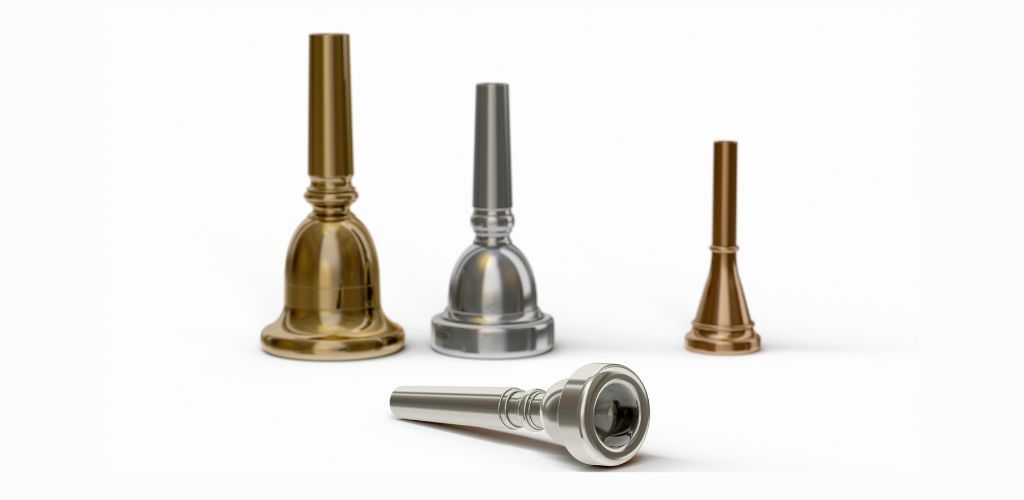
When I hunt for the perfect trumpet mouthpiece, I focus on two major themes: the great debate between standard and custom mouthpieces and the quest for the ideal size.
It’s like finding a key that fits the lock and turns with the right amount of give.
Standard Mouthpieces vs Custom Options
I’ve always found that standard mouthpieces serve as a reliable starting point. These are the ones that come with a trumpet when you buy it and are designed to cater to a broad range of players.
However, as my musical journey has evolved, I’ve sometimes felt the allure of custom mouthpieces.
Custom options allow me to express my unique playing style and to fine-tune my instrument’s response and tone. They can be sculpted to suit the demands of my embouchure or the genres I dabble in.
Yamaha TR-14A4a Standard Series Trumpet Mouthpiece

FEATURES: 16.68mm cup diameter provides extra power.
OTHER INFO: Shallow cup depth makes it easy to reach the highest notes.
- Medium-flat rim shape preserves your endurance.
- It pairs perfectly with a piccolo trumpet or lead trumpet player.
- Limited customization options.
When you click ‘Check Price’, you’ll see there are loads of great places to buy this item. Our personal favorite is Sweetwater for the US, and Thomann and Gear4Music for the UK & Europe.
They are the largest music retailers, with excellent customer service, competitive prices, really fast shipping, and the longest guarantees.
The professional musician who wrote this article combined many things,
from the product build, manufacturer’s reputation through to feedback
from other users, to create our famous TedScore™.
Mouthpiece Size and Compatibility
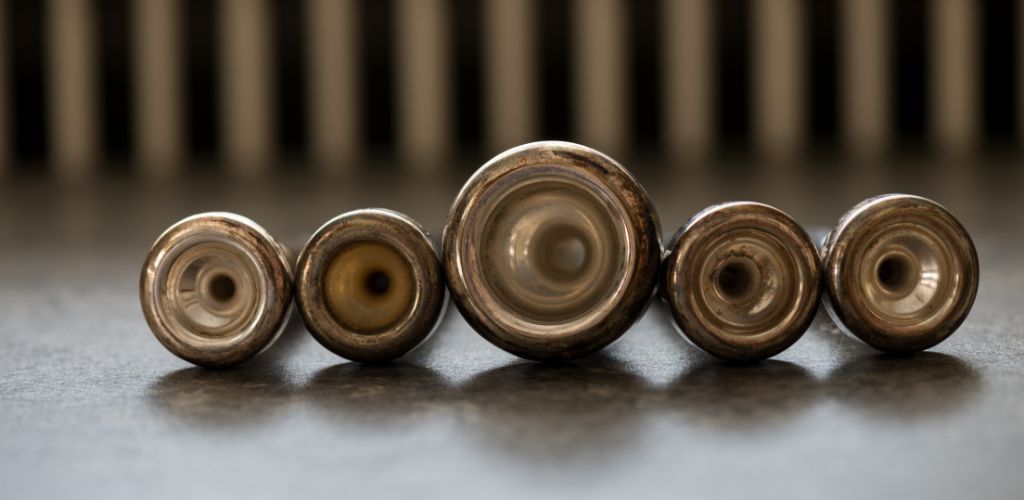
Choosing the right size is critical because it affects comfort and the sounds I can produce. A mouthpiece’s size generally includes the rim diameter, cup depth, and backbore.
Rim diameter is key in comfort, whereas cup depth and backbore influence the sound and ease of playing in different registers.
The mouthpiece size should also be compatible with my trumpet. It’s a tad technical, but a mismatch can result in poor intonation and a less-than-ideal playing experience.
Choosing Mouthpieces for Specific Genres
Picking the right mouthpiece for the trumpet can be a magical experience. It’s like finding the perfect glass slipper; it just has to be perfect for your style and the music’s nuances.
Jazz and Lead Trumpet Mouthpieces

The trumpet in a lively jazz band often dances above the mix like a spirited conversation.
A shallower cup depth ensures a bright, piercing tone ideal for jazz or lead playing. A mouthpiece like this lets my notes zing through the air, quickly reaching the back of the room.
Many jazz players also favor a mouthpiece with a slightly smaller diameter for more flexibility in their improvisation.
Yamaha TR-SHEW-JAZZ Bobby Shew Signature Jazz Trumpet Mouthpiece

FEATURES: Designed in collaboration with acclaimed trumpeter Bobby Shew.
OTHER INFO: Rim inner diameter: 16.85mm/ Cup depth: standard (medium)
- Provides a warm, snappy sound for jazz.
- Potential issues with compatibility with specific trumpet models.
When you click ‘Check Price’, you’ll see there are loads of great places to buy this item. Our personal favorite is Sweetwater for the US, and Thomann and Gear4Music for the UK & Europe.
They are the largest music retailers, with excellent customer service, competitive prices, really fast shipping, and the longest guarantees.
The professional musician who wrote this article combined many things,
from the product build, manufacturer’s reputation through to feedback
from other users, to create our famous TedScore™.
Classical and Orchestral Mouthpieces

I tend toward a different beast when I’m engrossed in classical or orchestral music.
I opt for a deeper cup depth and a larger diameter for richer, warmer sounds that blend smoothly.
With these mouthpieces, it’s all about control and a full spectrum of dynamics. The wider rim shape comforts my embouchure for those long Wagnerian operas or Tchaikovsky’s strong trumpet calls
Patrick Mouthpieces Classical Trumpet Mouthpiece
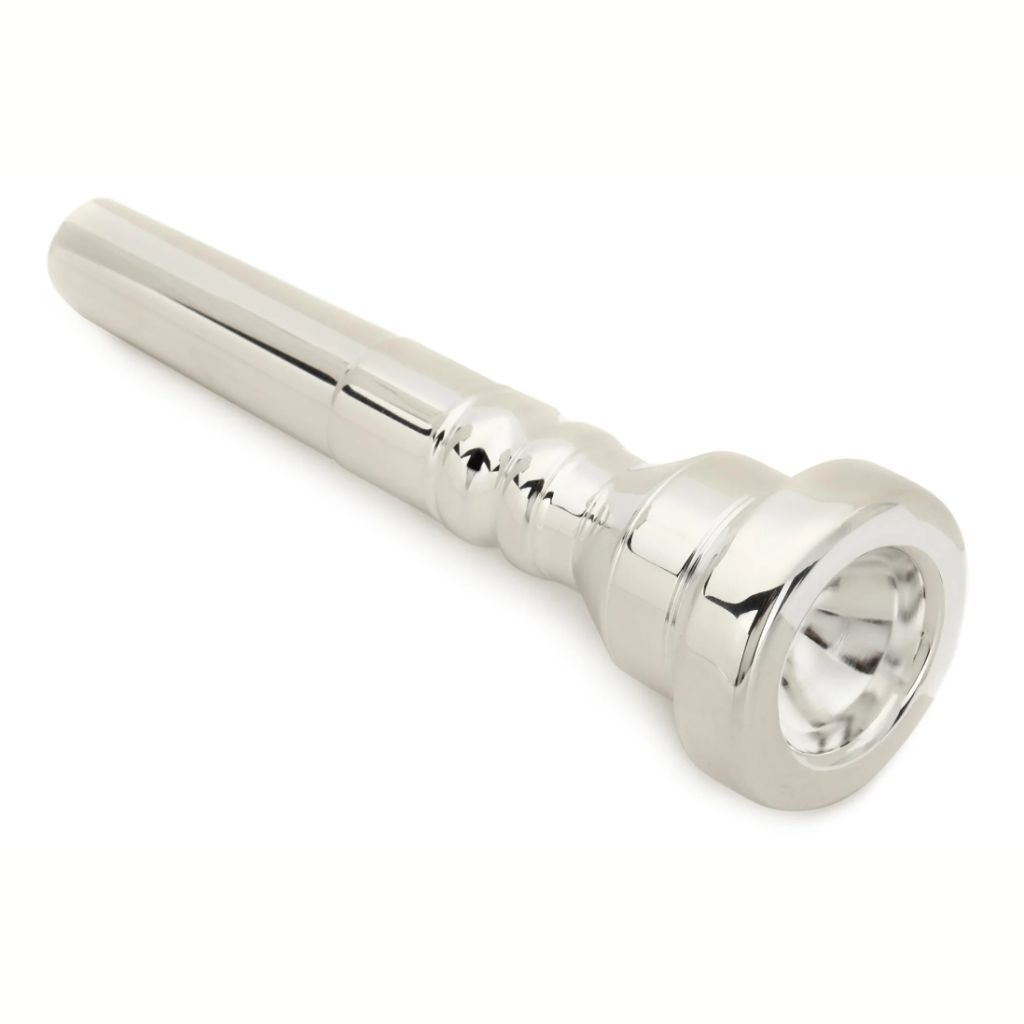
FEATURES: 3C cup shape and a 16.90mm inner diameter.
OTHER INFO: Features a standard #27 bore.
- An all-around trumpet mouthpiece with a round, dark-tinged sound.
- Limited availability in certain regions and potential variations in manufacturing consistency.
When you click ‘Check Price’, you’ll see there are loads of great places to buy this item. Our personal favorite is Sweetwater for the US, and Thomann and Gear4Music for the UK & Europe.
They are the largest music retailers, with excellent customer service, competitive prices, really fast shipping, and the longest guarantees.
The professional musician who wrote this article combined many things,
from the product build, manufacturer’s reputation through to feedback
from other users, to create our famous TedScore™.
Specialized Mouthpieces for Different Playing Styles
Selecting the right trumpet mouthpiece is like picking the perfect pair of shoes for an occasion; it can make all the difference to your comfort and performance.
Let me take you through what works best for different playing scenarios.
Lead vs. Section Playing

With lead trumpet playing, they belt out those high notes with remarkable clarity, and so reach for a mouthpiece with a shallower cup. This design ensures high notes are more accessible to hit and helps maintain lasting endurance when playing the lead trumpet.
On the flip side, when I melt into the embrace of a section, I gravitate towards a deeper cup mouthpiece. It enriches my trumpet’s voice with a darker sound and blends smoothly with other instruments.
This style of mouthpiece allows for a fuller range and complements the collective sound rather than trying to eclipse it.

Soloist vs Ensemble Preferences

Solo moments are special— they’re my chance to shine and share my voice.
To capture that character in my songs, I choose a mouthpiece that compromises between the extremes of bright and dark sounds.
It delivers a flexible sound with enough brightness to stand out, yet its richness tells my story.
But when it’s time to join an ensemble where harmony is vital, I opt for a mouthpiece that promotes a mellow, unifying timbre.

It’s not just about blending in; it’s about contributing to the cohesive sonic tapestry we’re all weaving together.
A balanced sound reigns supreme, ensuring I add to the ensemble’s depth without overwhelming my bandmates.
Types of Mouthpiece Materials
In the enchanting world of trumpet mouthpieces, the material can make quite a difference in playability and sound. Let’s explore together, shall we?
Comparing Brass, Silver, and Gold
I’ll start with brass, the classic. It’s durable and has a clear, bright sound that many players cherish. It’s often plated with other materials to enhance its qualities.
Silver simply gives a warmer tone than brass. Silver plating is a common choice for its refined sound and comfortable feel on the lips—plus, it’s not too pricey!
Moving on to gold, it’s all about warmth and smoothness. Gold-plated mouthpieces offer a rich tone and are gentle on the chops but come with a heftier price tag. They’re a treat for both the player and the listener.
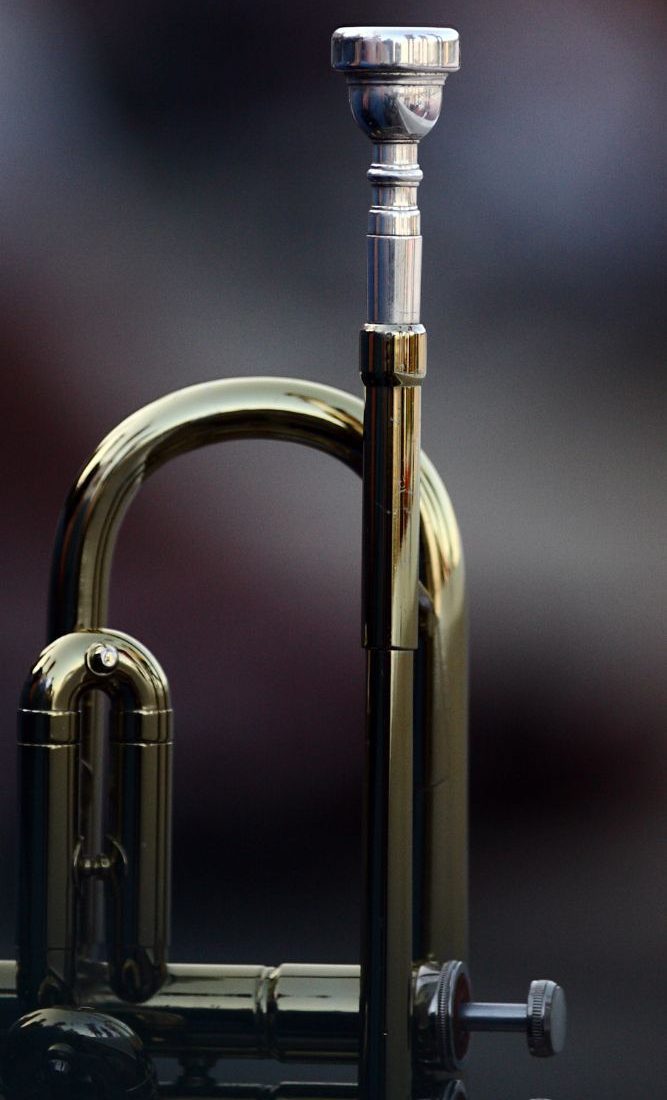
Alternative Materials: Plastic and Others
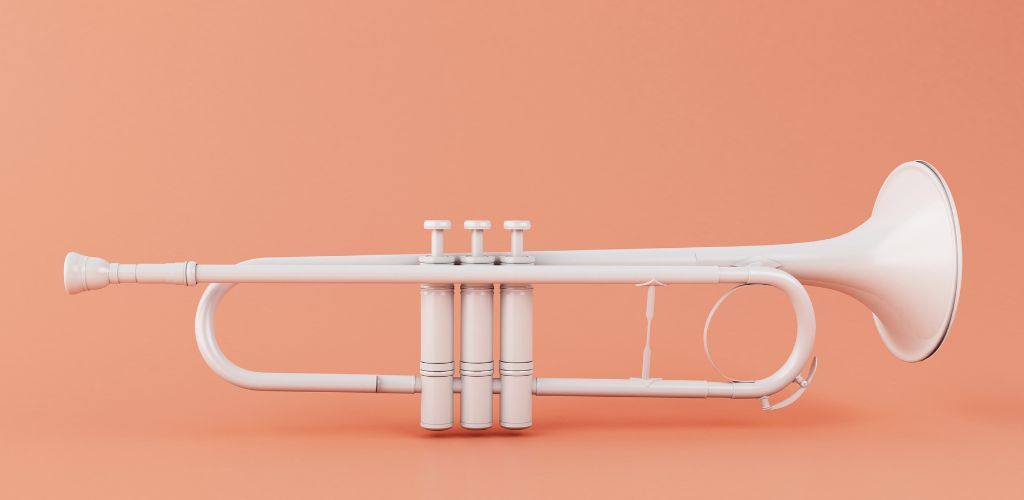
Plastic: Plastic mouthpieces are kind to your lips, especially in cold weather. They come in various fun colors and are budget-friendly, but remember they might not match the sound quality of their metal counterparts.
Other materials include stainless steel, titanium, and even rubber.
Each has unique characteristics, but they’re more of a niche market. A stainless steel mouthpiece feels stable, titanium boasts strength without the extra weight, and rubber provides a comfortable cushion for your lips.
Additional Information
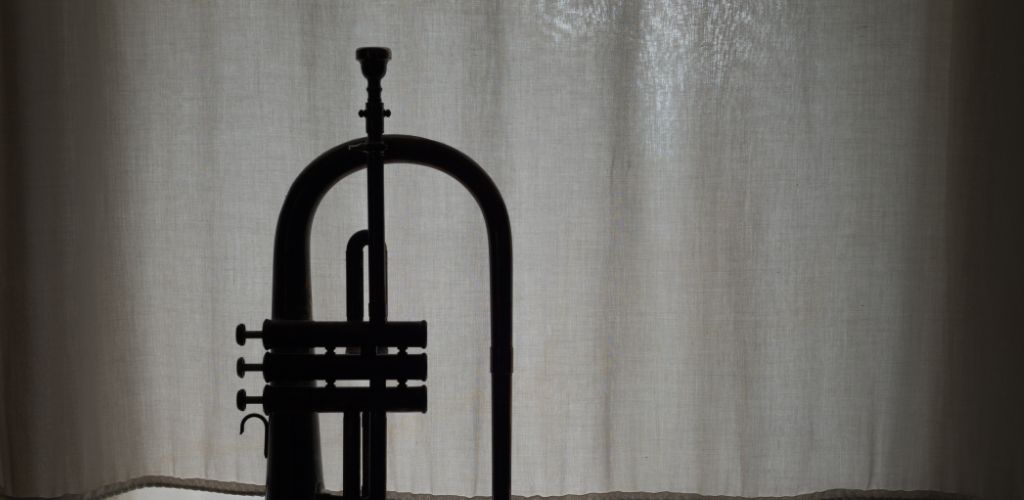
Flugelhorn mouthpieces are explicitly designed for the flugelhorn and are not the same as trumpet mouthpieces.
While they may appear to be the same mouthpiece, flugelhorn mouthpieces are engineered to accommodate the flugelhorn’s unique characteristics and playing requirements.
Using a trumpet mouthpiece on a flugelhorn offers a different sound and playing experience.
The Role of Mouthpiece Shape and Size

I will walk you through just how pivotal the shape and size of a trumpet mouthpiece are in crafting your unique sound. Each piece of the mouthpiece formula – from the rim to the backbore – can tweak the timbre and playability.
The Impact of Rim Shape and Diameter
The rim is where comfort meets performance. Its shape and diameter directly influence my endurance and accuracy.
A rounded rim shape is marvelous for comfort, while a sharper one bolster precision. As for the diameter, a larger one grants a fuller sound, but it can be more demanding to play.
Understanding Cup Depth and Shapes
Diving into cup depth and shape is thrilling – they truly shape my sound.
A deep cup offers a rich, dark tone ideal for orchestral music, while a shallow cup brightens the sound, perfect for jazz or lead trumpet. Cup shapes, typically either “U” or “V,” determine the timbre and subtly resist the airflow.
Throat and Back bore Variations
Now, let’s chat about the throat and back bore – these two are the unsung heroes of sound projection and quality.
A wider throat size allows for a bigger volume but requires more air, so it’s quite a workout.
The back bore’s taper governs the trumpet’s resistance and tone – a tighter backbore produces a focused sound, whereas a larger one has a more accessible feel and a broader sound.
Understanding the Basics of Trumpet Mouthpieces
Engaging with trumpet mouthpieces is like becoming a detective. Every tiny piece of the puzzle contributes to your trumpet’s vibrant story.
Anatomy of a Mouthpiece
Let me introduce you to the rim. It’s the area where my lips meet the mouthpiece, and its comfort is paramount for control and endurance.
In its cozy, concave glory, the cup nestles my lips and influences the timbre of notes.
Moving deeper into the mouthpiece, we encounter the throat. This is the narrowest passage where my lips buzzing becomes an exuberant musical note.
It leads into the backbore, which shapes the sound as it travels into the trumpet.

Functions of Mouthpiece Parts

The rim is not just a pretty edge; it gives me the platform to establish clear articulation. It’s the conductor of my lip vibrations. The cup serves a dual function: its shape and depth juggle the warmth and brightness of my sound.
The bore is like a behind-the-scenes stage manager for my mouthpiece.
Determining resistance and airflow plays a subtle but pivotal role in sound production. The back bore finishes the job, ensuring my sound is projected far and wide with proper intonation.
How Mouthpiece Selection Can Improve Range and Endurance
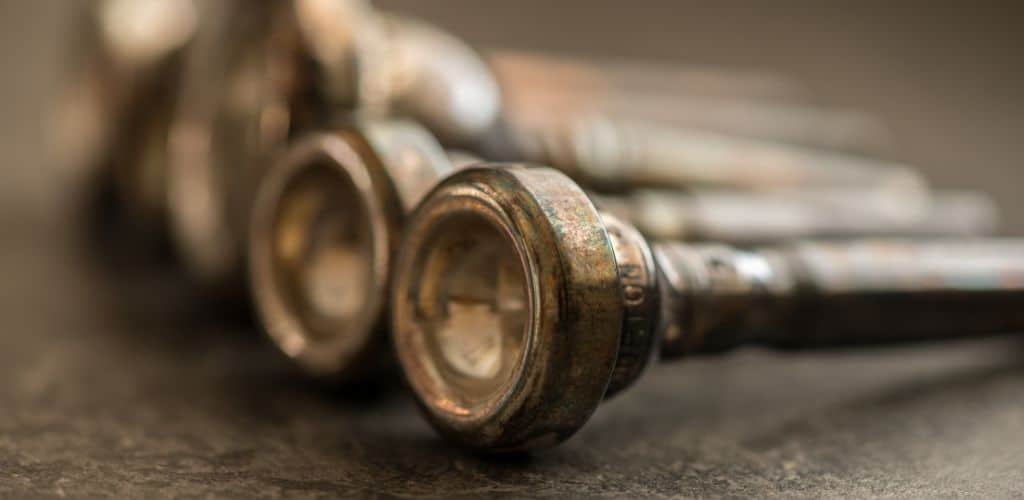
When looking for the perfect trumpet mouthpiece, I always consider how it will affect my range and endurance.
Nailing those high notes and playing for long periods without fatigue is crucial, and believe me, the right mouthpiece is like a secret weapon in my arsenal.
High Note Performance Mouthpieces
For those dazzling high notes, shallow cup mouthpieces are my go-to. They help me hit the stratosphere with less effort.
A shallow cup typically means less air is needed, so I can focus on precision and clarity without huffing and puffing.
However, it’s more than just the ease of playing high notes. Shallow cups can also enhance the brightness of the sound – perfect for genres where I want to stand out, like jazz or lead parts in a band.
Deep vs Shallow Cups for Endurance
Now let’s chat about deep cups – they’re like a comfortable armchair for my chops. More bottomless cups offer a warmer sound and are superb for classical pieces where I’m after a rich, full-bodied tone. But the trade-off can be my endurance.
Conversely, a shallow mouthpiece cup can keep me going like the Energizer Bunny. It helps me maintain energy, especially during those marathon gigs or sessions.
With less lip fatigue, I can play longer and feel fresher.
Effect of Mouthpiece on Tone and Intonation
When I pick out a trumpet mouthpiece, the shape and size immediately tell me how it will affect my sound and tuning.
Now, let’s explore how this little piece of kit can sculpt your musical voice and keep your notes spot-on!
Achieving Warmth or Brightness in Tone

I’ve noticed that a deeper cup mouthpiece cradles my sound, giving it a warmer, more mellow character. It’s like wrapping your tone in a cozy blanket.
On the flip side, a shallower cup cheers on a brighter and more piercing tone, perfect for when you want your trumpet to cut through the mix.
Accuracy and Stability in Pitch

The dimensions of a mouthpiece influence how comfortably I can hold a note steady. A mismatch between my embouchure and the mouthpiece could send my pitch wandering.
That’s why, for stable intonation, I ensure the bore size aligns with my playing style; a size 27 bore usually strikes a delightful balance that keeps notes in check.
Tips for Beginners and Advanced Trumpet Players
Mouthpiece Advice for New Players

When I first started playing the trumpet, I wish I’d known that the mouthpiece could make or break my experience.
For beginners, choosing a mouthpiece that balances flexible playability and enough resistance to aid in muscle development is vital.
A medium-sized mouthpiece, like the recommended Bach mouthpiece, usually strikes the right chord with a comfortable rim and a cup size that’s not too shallow or deep. Bach mouthpieces ensure a solid foundation for producing clear notes across the range.
Bach K351 Mega Tone Trumpet Mouthpiece - 3C
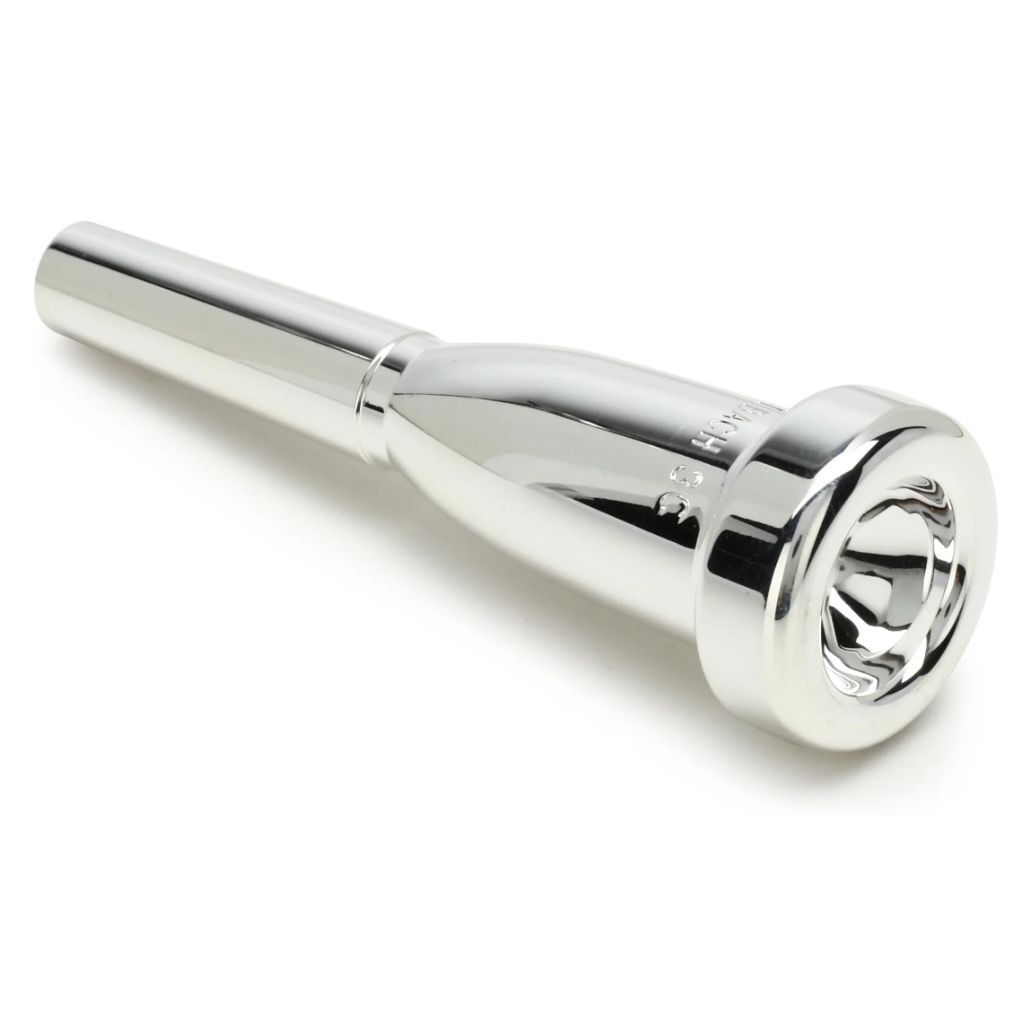
FEATURES: 3C cup, medium depth, 16.30mm diameter, and a medium-wide rim shape.
OTHER INFO: High-mass, larger-throat construction for a darker tone and distortion-free performance.
- Designed as an all-around mouthpiece.
- Relatively heavier compared to standard mouthpieces.
When you click ‘Check Price’, you’ll see there are loads of great places to buy this item. Our personal favorite is Sweetwater for the US, and Thomann and Gear4Music for the UK & Europe.
They are the largest music retailers, with excellent customer service, competitive prices, really fast shipping, and the longest guarantees.
The professional musician who wrote this article combined many things,
from the product build, manufacturer’s reputation through to feedback
from other users, to create our famous TedScore™.
Advanced Techniques and Mouthpiece Features
As an advanced player, I’ve learned that the quest for the ultimate mouthpiece is all about fine-tuning. The throat and back bore of the mouthpiece, in particular, are crucial for manipulating sound volume and timbre.
You’ll want a mouthpiece that can accommodate advanced techniques such as extended-range playing and fast technical passages.
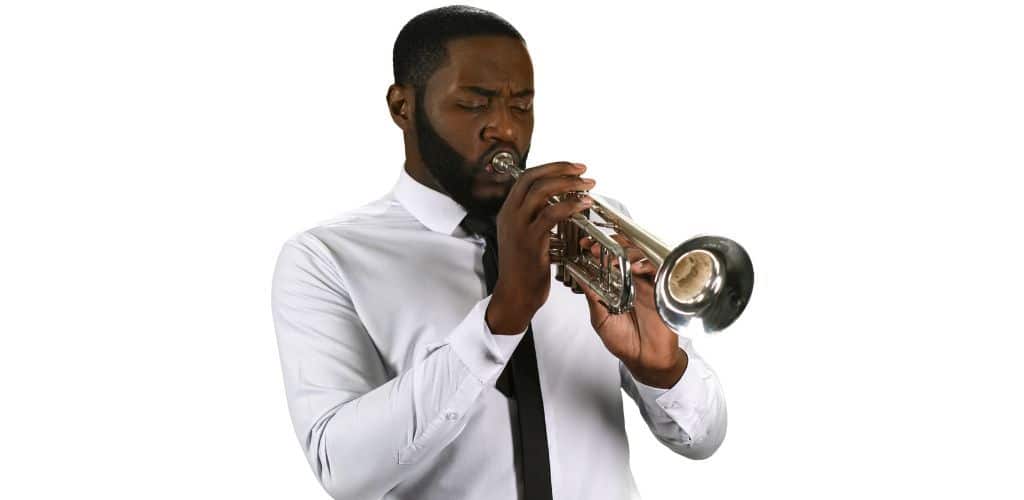
For us pros, experimenting with different throat sizes and back bore configurations is key to finding that signature sound. A slightly larger throat can offer less resistance; some players prefer a fuller sound or higher volume.
Meanwhile, the back bore affects the ease of playing in the upper register and can influence your sound’s overall focus and color.
Caring for and Maintaining Your Mouthpiece
Keeping a trumpet mouthpiece in top condition requires regular care and understanding when it’s time for a new one. A simple bit of brass can make a difference in your practice and performance.
Cleaning and Maintenance Techniques

Regular cleaning keeps my mouthpiece gleaming and grime-free, which can affect the sound quality.
A soft brush and some warm, soapy water do the trick nicely to remove any build-up. Thoroughly rinse with cool water post-scrub to avoid any soap residue.
Giving it a soak in a mouthpiece sanitizing solution now and then adds that extra level of cleanliness, especially during flu season. Be sure to dry it completely with a soft, lint-free cloth to prevent water spots or corrosion.
And don’t forget: a well-maintained mouthpiece is crucial for stellar performance.
When to Replace Your Mouthpiece
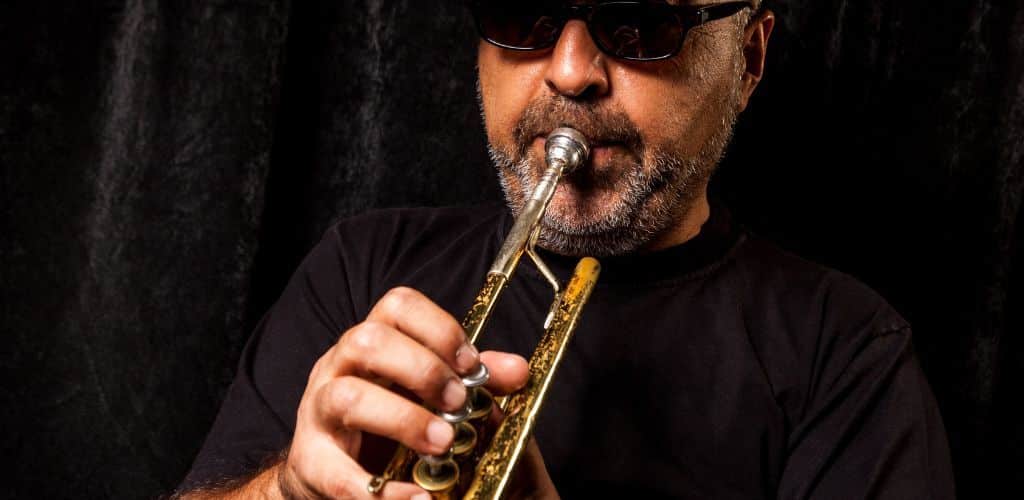
I always look for signs of wear and tear, as these can be a cue that it’s time to hunt down a shiny new sidekick for my trumpet.
If I start noticing that the plating is wearing thin or if there are any minor dents, it tells me my tone could suffer. That’s when I know it’s time to replace my mouthpiece.
Mouthpieces also tend to have a personal lifespan depending on how often and vigorously I practice.
The moment I feel like my sound isn’t what it used to be, the playing becomes uncomfortable; it’s a clear signal to invest in a new one.
After all, a comfortable mouthpiece is essential to keeping chops in top form.
Types of Trumpet Mouthpieces:
Recap
Choosing a mouthpiece is a personalized adventure, with each player’s unique lips steering the ship.
The cup depth greatly influences tone, with shallower cups making my higher notes zing to the heavens and deeper ones adding a sonorous quality to my lower register.
Next up, the rim shape takes the helm for comfort and control. A rounder rim provides a cozy home for my embouchure, while a sharper one can demand more precision and stamina.
Then there’s the backbore shape, plunging into the depths of sound versatility—the more comprehensive the backbore, the more open and free-flowing my playing feels.
This has revealed that my mouthpiece choice is a decisive factor in my trumpet’s voice. Indeed, it’s about pairing the right tool with your style and the quirks of your beloved horn.
Here’s to never-ending discoveries and the joy of trumpeting your tune! It’s time to play a cheeky tune, celebrating the perfect mouthpiece match.
Hold on! There’s more…
Discover the best trumpet practice mutes to enhance your playing experience.
FAQ's
The 7C trumpet mouthpiece generally has a shallower cup and smaller diameter than the 3C mouthpiece, which typically features a more bottomless cup and larger diameter. These differences can impact trumpet players’ sound, range, and overall playability, with the 3C often providing a fuller tone and more resistance compared to the 7C.
There are various trumpet mouthpieces designed for different playing styles, such as classical, jazz, and commercial music. Additionally, trumpet mouthpieces come in different sizes and shapes to accommodate the preferences and needs of individual players.
The best trumpet mouthpiece depends on the player’s preferences, playing style, and the specific sound they want to achieve. Try different mouthpieces to find the one that best suits your playing and musical goals.
The choice between a 5C and a 3C trumpet mouthpiece depends on the player’s preferences, playing style, and the specific sound they aim to achieve. The 3C has a very shallow cup than the 5C cup.












does it matter what mouthpiece i use if i’m just starting out? kinda confuse
Interesting points on materials, but I’ve found that alternative materials like plastic can sometimes offer unique benefits not mentioned here, especially for those of us experimenting with electronic and synthesized tones. While brass, silver, and gold are certainly the standards, don’t knock the synthetics till you try them. They can surprise you.
This article provides an excellent foundation for selecting the right mouthpiece. In my band, I often see students struggle with their tone and range simply because they’re not paired with the optimal mouthpiece for their instrument and style. I’ll be recommending this read to them.
Toby Coles really hits the high notes with this article on choosing the right trumpet mouthpiece! As someone who dabbles in jazz and has struggled to find the perfect mouthpiece for those smokey solos, the breakdown between jazz and lead trumpet mouthpieces is pure gold. Never realized how much of a difference the right piece can make in sound until I experimented based on advice like this. Spot on with the recommendations!
@BrassyBroad Definitely start with something more standard and versatile before experimenting. It makes a huge difference as you find your style!
hey SaxMan88, got any tips for a newbie on picking a first mouthpiece?